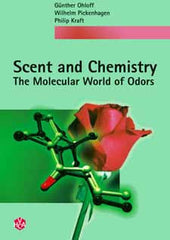Scent and Chemistry The Molecular World of Odors by Günther Ohloff
Scent and Chemistry
The Molecular World of Odors
by Günther Ohloff
Scent and Chemistry: The Molecular World of Odors presents a vivid and up-to-date picture of the chemistry of odorants and the research in odor perception.
Coverage includes:
- the molecular basis of olfaction
- olfactory characterization of perfumery materials
- structure-odor relationships
- chemical synthesis of odorants
- chemistry of essential oils and odorants from the animal kingdom
- notes in perfumery for each essential oil
Contents
1. Historical Aspects
- Scents of Time
- Chemical Discoveries and Modern Perfumery
2. The Chemical Senses
- Anatomy, Physiology, and Biochemistry of Olfactory Receptors
- Historical Aspects
- Description and Classification of Odor Impressions
- Historical AspectsQuantitative Odor Perception
3. Structure-Odor Relationships
- Physicochemical Properties of Odorants and the Concept of Osmophoric Groups
- Structure-Odor Correlations
- Molecular Shape and Odor – The Early Theories
- The Concept of Profile and Bulky Groups
- Unsaturated Compounds
- Diastereoisomers
- Steroid-Type Odorants
- Odor Rules
- Bifunctional Units: Mugent and Caramel Odorants
- QSAR: Homology vs. Olfactophore Models
- Enantioselectivity of the Odor Sensation
4. Odorants from Natural Sources
- Important Terpene Building Blocks
- Odorants from α- and β-Pinene
- Synthetic Odorants from Cyclic Monoterpenes
- Acyclic Odorants of the Monoterpene Series
- Odorants from 3,7-Dimethylocta-1,6-diene
- Odorants by Functionalization of Myrcene
- Odorants from (-)-Caryophyllene and (+)-Longifolene
- Odorants from α=Cedrene and Thujopsene
5. Odorants from Petrochemical Sources
- Isoprene as Starting Material for the Synthesis of Odorants
- Isobutene and 3-Methylbut-1-en-2-ol as Starting Materials
- Terpenoids from Isobutene
- (-)-Menthol
6. Ionones, Damascones, and Iso E Super
- Violet and Orris Odorants
- Rose Ketones
- Isocyclemones: Ionone-Type materials in Perfumery
7. Essential Oils
- Citrus Oils
- Petigrain Oil
- Neroli Oil/Orange Blossoms
- Lavender Oil
- Clary Sage Oil
- Patchouli Oil
- Jasmine Absolute
- Rose Oil
- Geranium Oil
- Violet Oil
- Orris
- Osmanthus Oil
- Vetiver Oil
- Cedarwood Oil
- Sandalwood Oil
- Galbanum
- Labdanum
- Oakmoss
- Incense and Myrrh
- Black and Pink Pepper
8. Odorants of Animal Origin
- Musk and Civet
- Industrial Synthesis of Macrocyclic Odorants
- Non-Natural Musks
- Ambergris
- Castoreum
Index
XCustomer Reviews
Based on 1 review
Write a review


















